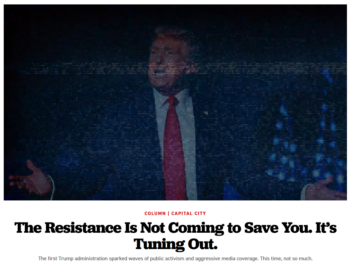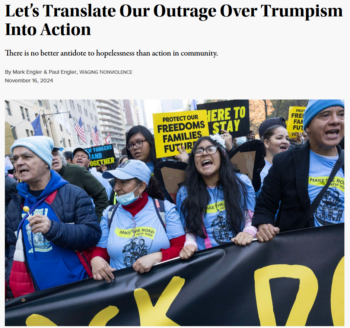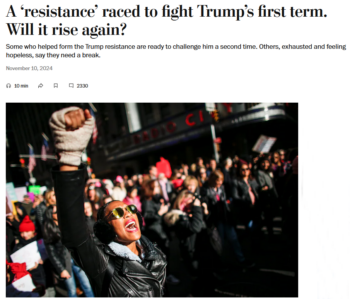Ten months before the 2024 election, high-profile news outlets were already sounding the alarm: If Trump were to win another term, widespread fatigue, despair and activist burnout would probably minimize resistance.
Exhaustion and burnout are real phenomena that pose a significant challenge to political movements (Psychology Today, 6/24/20). But articles that focus on feelings of burnout, and exclude or downplay questions of changes in strategy amid shifting conditions, often have the effect—and occasionally the goal—of making everyday people seem and feel less powerful than they are.

A year ago, Politico‘s Michael Schaffer (1/26/24) was predicting that a Trump victory might “be met with avoidance, listlessness and apathy.”
Politico writer Michael Schaffer (1/26/24) noted a year ago that the shock of Trump’s 2016 victory “sparked a burst of activity that profoundly altered Washington”:
Donations to progressive advocacy groups soared. Traffic to political media spiked. Protests filled the calendar…. But now, as a second Trump term becomes an increasingly real possibility, there’s no consensus that anything similar would happen in January 2025.
While acknowledging that the post-2016 burst of activity had profoundly altered Washington, Politico warned Trump opponents that pioneering new strategies would only get them so far, since passivity in the face of a second Trump term “has as much to do with psychology as it does with the tactics or organizational skill of the activist class.”
Humans “respond to a sudden threat with a fight-or-flight instinct,” Schaffer observed, and for many, “the string of jolts that accompanied the first Trump months of 2017—the Muslim ban, the firing of James Comey, Charlottesville—spurred an impulse to fight.” The same was unlikely to be true of a second Trump win, he speculated, because for many it would amount to proof that fighting back “wasn’t enough,” and could “just as easily be met with avoidance, listlessness and apathy.”
Good journalists don’t pretend an energetic and cohesive resistance exists when it does not. But presenting opposition to authoritarians like Trump as pointless, ineffectual and doomed is journalistically irresponsible and historically illiterate, particularly when it’s clear that the initial backlash to Trump had an effect (New York Times, 12/18/17).
‘A weary shrug’
After the election, Politico again predicted a muted response to Trump’s second term. A Politico EU story (11/13/24) characterized the 2024 Trump resistance as “flaccid” (“Toto, we’re not in 2016 anymore,” read the subhead), and proclaimed that while Trump’s 2016 win had “sparked a global revolt,” his recent triumph has been “met with a weary shrug.”
The outlet suggested that Trump’s latest win had been inevitable—
part of a broader, inexorable rightward trend on both sides of the Atlantic, leaving a dejected liberal left to helplessly scratch their heads as the fickle tide of political history turns against them.
Which might leave anti-Trump readers wondering: Don’t humans have a role to play in turning history’s tide?

After the election, Politico‘s Schaffer (11/15/24) presented the exodus from the far-right X (formerly Twitter) as a sign that “the post-election progressive ferment that in 2016 gave us the resistance is going to be a lot quieter this time.”
A couple of days later, Schaffer (Politico, 11/15/24) wrote a column headlined “The Resistance Is Not Coming to Save You. It’s Tuning Out.” Noting a decline in critical coverage of Trump, Schaffer wrote that for a nation
wondering whether the return of Trump will drive an immediate return of the public fury and journalistic energy triggered by his first win, it makes for an early hint that the answer will be: Nope.
Where Trump’s first victory “triggered Blue America’s fight instinct,” he added, “the aftermath of this year’s win is looking a lot more like flight.” The question of why so many Americans are now in “fight or flight” mode went largely unexamined. Schaffer’s main takeaway was that Blue America cannot credibly blame a “feckless pre-election press” for “bungl[ing] the coverage” of the race this time around, as if alarmist corporate media coverage of crime, immigration, the economy and transgender issues didn’t contribute to Trump’s narrow victory in 2024.
He also faulted the initial resistance to Trump for being “organized around issues of identity,” citing as examples the 2017 Women’s March, the backlash to the Muslim ban, the 2017 counter-protest against a white supremacist rally in Charlottesville, and the 2020 racial justice protests. But the fact that the Women’s March drew people of all genders, most participants in the 2020 racial justice protests were white, and Black Lives Matter may have been the largest protest movement in US history suggests that many Americans find issues of “identity” galvanizing rather than alienating.
And it is likelier that direct threats to people’s lives—say, those posed by mass deportations and abortion bans—will inspire more re-engagement than vague appeals to issues like preserving democracy.
Reformulated opposition

Truthout (11/16/24): “As we step out of our grieving and look ahead, there are reasons to believe that a new social movement cycle to confront Trumpism can emerge.”
It’s true that while Trump’s 2016 victory came as a horrific shock to millions, in part because Hillary Clinton was widely expected to win, the outcome of the 2024 election was less surprising, since no candidate seemed assured of victory. But torpor is just one aspect of an unfolding story; opposition to Trump’s agenda is not muted so much as it is being reformulated in response to changing conditions.
Thousands continue to protest Israel’s ongoing genocide, despite elite media outlets’ and universities’ war on free speech and student protesters. Two days after the 2024 election, more than 100,000 people joined a call organized by a coalition of 200 progressive groups, including the Working Families Party, Indivisible, United We Dream and Movement for Black Lives Action, and thousands signed up for follow-up actions.
As it did in and after 2016, Trump’s recent election has spurred thousands to join organizations like the Democratic Socialists of America, to which I belong. Public support for organized labor remains extremely high—70% of Americans approve of labor unions—and the US continues to experience an uptick in militant labor actions, including recent strikes at major companies like Starbucks and Amazon. Finally, many organizers are focused on developing strategies to combat Trump policies, like mass deportations, as soon as he attempts to impose them.
‘Get somebody else to do it’

“How Powerful Leaders Crush Dissent, Demobilizing Millions,” might have been a more appropriate headline for this New York Times piece (11/20/24).
The New York Times has also been obsessed with the allegedly neutered 2024 resistance. “In 2017, [anti-Trump voters] donned pink hats to march on Washington, registering their fury with Donald J. Trump by the hundreds of thousands,” reporter Katie Glueck (2/19/24) wrote, adding, “This year, [they] are grappling with another powerful sentiment: exhaustion.”
Weeks after the election, the paper published “‘Get Somebody Else to Do It’: Trump Resistance Encounters Fatigue” (11/20/24). The subhead read, “Donald J. Trump’s grass-roots opponents search for a new playbook as they reckon with how little they accomplished during his first term.”
In the piece itself, reporter Katie Benner offered a balance of voices of both the exhausted and the motivated, accompanied by a fairly nuanced assessment of the situation facing the anti-Trump resistance, describing “a sharp global reversal in the power of mass action” that may be partly due to governments’ authoritarian drift and declining willingness to change course in response to public pressure. But the paper’s headline writers erased that nuance and the role of repression, leaving only a sense that activists are personally failing. As headlines go, “How Powerful Leaders Crush Dissent, Demobilizing Millions” might have been more accurate.
In December, New York Times columnist and Trump critic Charles Blow (12/18/24) offered weary progressives absolution: “Temporarily Disconnected From Politics? Feel No Guilt About It.” Though he cautioned that it would be “a mistake for anyone to confuse a temporary disconnection for a permanent acquiescence,” he suggested that there were, at the moment, few ways to fight back.
After all, Blow wrote, “there is very little that average citizens can do about the way the administration takes shape”—seeming to forget that cabinet members must be confirmed by the Senate, which is an elected representative body. Even efforts to counter Trump’s agenda led by groups like the American Civil Liberties Union (ACLU), he noted, are “largely beyond the involvement of average citizens.” (That would probably be news to the ACLU, which is often seeking volunteers, and always seeking donations.)
Even columnists like Blow, who has called Trump an “aberration and abomination,” are apparently more interested in chronicling progressive fatigue than in contending with two troubling shifts noted by the New York Times: a global decline in the power of mass action, and self-proclaimed champion of democracy President Joe Biden’s refusal to respond to the majority of Americans who oppose Israel’s war.
When large groups of Americans cannot sway their leaders via forceful dissent, mass action or electoral campaigns—when participating in politics feels, and often is, useless—some degree of disengagement is inevitable.
‘In no mood to organize’

The Washington Post (11/10/24) presented the mood of today’s activists: “I’m feeling like I want to curl up in the fetal position.”
The Washington Post (11/10/24), under the headline, “A ‘Resistance’ Raced to Fight Trump’s First Term. Will It Rise Again?” noted in its subhead that some who had been a part of that resistance were “exhausted and feeling hopeless,” and “say they need a break.” The piece described an activist, who’d been “shocked into action” by Trump’s 2016 victory, as “in no mood to organize” in 2024. Although many had been “jolted” into opposing Trump in 2016, today’s resistance leaders “must contend with a swirl of other feelings: exhaustion, dejection, burnout.”
Yet despite their exhaustion, ordinary people around the country and world are still organizing, because they know how much worse things can get if they don’t—and because it’s their bodies, families and communities on the line. Having seen how hard it is to make change, even when a policy or cause has majority popular support, it’s no wonder that some are taking a short- to long-term break from politics.
It’s not the public but elite journalists, chastened by their tarnished reputation and their contributions to Trump’s rise, who have shrunk from challenging the powerful, whether those in power are genocide-supporting Democrats like Biden, or planet-betraying authoritarians like Trump.
This content originally appeared on FAIR and was authored by Raina Lipsitz.
Raina Lipsitz | Radio Free (2025-01-17T19:40:01+00:00) Diagnosing Activist Burnout, Elite Media Fuel It. Retrieved from https://www.radiofree.org/2025/01/17/diagnosing-activist-burnout-elite-media-fuel-it/
Please log in to upload a file.
There are no updates yet.
Click the Upload button above to add an update.